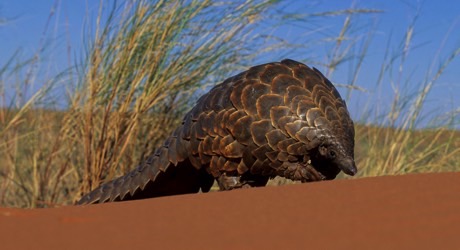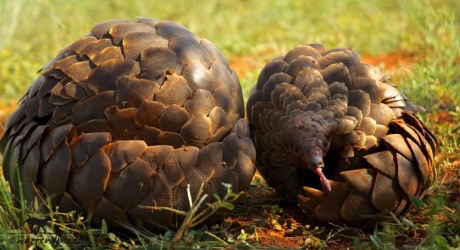Project Background
Pangolins hold the unfortunate title of being the world’s most trafficked wild mammals – they are hunted to supply a rampant illegal trade in their scales, meat, and body parts. Because of demand – mostly in Asia, where pangolin meat is considered a delicacy and their scales are believed to have medicinal properties – all eight pangolin species are threatened with extinction. This includes the Temminck’s Pangolin (Smutsia temminckii), which is the widest-ranging of the four African pangolin species and the focus of this project.
The single biggest threat currently facing pangolins in South Africa is not poaching, as it is in most other places, but accidental electrocution on electrified fences. A previous study has estimated that as many as 1,200 pangolins are killed on electrified fences in southern Africa every year, along with a myriad of other species that suffer the same fate. These accidental electrocutions are placing a species that is already threatened by illegal trafficking and habitat loss under even more threat; and yet of all the threats facing pangolins, modifying the electrified fences is arguably the easiest to achieve.
Key Project Activities
The generous funding provided by World Nomads enabled the following activities:
- Establishing a new Tikki Hywood Foundation office in South Africa. This includes office equipment, telecommunications and vehicle maintenance costs. The new office was used as a base to launch this critical work.
- Support for Dr. Darren Pietersen, who is the Head of Research for Tikki Hywood Foundation and is based in South Africa. Dr. Pietersen is one of the key developers of a revolutionary new wildlife-safe fence system that prevents pangolins from curling around the fence and being repeatedly shocked. Instead they are able to move away rather than being accidentally killed through electrocution.
- Dr. Darren Pietersen is now leading the field-testing and modification of these fences at seven sites in South Africa.
Key Project Outcomes
The following has been enabled through this generous grant:
- A Tikki Hywood Foundation project field site office has been established in South Africa.
- Dr. Darren Pietersen, together with other project partners, is working with livestock and game farmers to trial the new systems. The new systems have been installed at seven sites across South Africa, with field testing well underway. The results of this field-testing are being used to modify the systems and fences to ensure that they are as effective as possible.
- This project has enabled close working with the South African government Ministry of the Environment who are a key partner and may adopt a national policy for this to be the standard design for all electrified wildlife fences going forward.
- This grant has also enabled collaboration with Pangolin.Africa, who have helped to raise additional funds for this project.
- Tikki Hywood Foundation continues to engage with, and where appropriate assist, local and regional NGOs that are engaged with pangolin conservation. This includes the assembly of care packages for several orphaned pangolins. Having a base in South Africa has greatly increased the speed with which these packages could be assembled and dispatched.
Community Involvement
This project involves working closely with the farming communities in both the Northern Cape and Limpopo provinces of South Africa. It has helped to create awareness for smaller animals, and particularly pangolins, among these farming communities. In particular, farmers have been concerned about the numbers of small animals killed by electrified fences on their farms and have wanted to find a low-cost solution, and this project has helped to find such a solution. This in turn has achieved buy-in from local farming communities as they can see the potential to protect their livestock while at the same time living in coexistence with small animals such as pangolins.
What's Next?
This project is still ongoing and is in the field-testing phase across seven sites. Dr. Darren Pietersen is visiting the sites on a regular basis to ensure that the energizers are working properly for the length of the fences and the distances being linked. Following design modifications, it is hoped that this project will be rolled out on a national scale in South Africa, and there is potential for it to be adopted in other pangolin range states across Africa.
Can I visit this project?
This is a ground-breaking project that is still ongoing. Unfortunately, it is not possible for travelers to visit the project as it is being run on private properties.
Project Background
The pangolin holds the unfortunate title of the world’s most trafficked animal – they are hunted to supply a rampant illegal trade in their scales, meat, and body parts. Because of demand – mostly in Asia, where pangolin meat is considered a delicacy and their scales are believed to have medicinal qualities – all eight species of pangolins are threatened with extinction.
This includes the Temminck’s Ground Pangolin (Smutsia temminckii), which is the widest-ranging of the four African pangolin species and the focus of this project. The biggest threat facing pangolins in southern Africa is not poaching, as it is in most other places, but accidental electrocution on electric fences. A previous study has estimated that as many as 1,200 pangolins are killed by electric fences in southern Africa every year, along with a myriad of other species that suffer the same fate.
These accidental electrocutions are placing a species that is already heavily threatened by illegal trafficking and habitat loss under even more threat; and yet of all the threats facing pangolins, modifying the electric fences is arguably the easiest to achieve and also has the potential to positively influence the local pangolin populations within a relatively short span of time.
Project Overview
This project aims to further develop and field-test a device that can be both retrofitted to existing electric fences and incorporated into the energizer designs to ensure that new fences are pangolin-friendly. Our goal is that this will eventually be incorporated into the standard design for electric fences in the regions of southern Africa where pangolins are found. The modifications to be added to existing electric fences have been identified through previous work, and prototypes have been developed with a qualified electrical engineer.

We will begin field-testing by selecting two adjoining sections of electric fence – the prototype device will be installed on one section, and the other section (the control) will be left as is. The habitat and geology of the site must be consistent to ensure that the results are comparable across the two sections.
The first two months of field-testing will be used to identify and implement any further design modifications that may be required; after this, we will leave the components to run for at least six months to ensure we have sufficient data. Following that period of data collection and any subsequent final design tweaks, we will have the device produced for retro-fitting on existing electric fences.
We will also engage with local fencing companies and local/national conservation authorities to have the new components a) incorporated into energizer designs and b) included in provincial and national fencing norms and standards.
What's Covered in Project Costs
Funding from the Footprints Network will go towards:
- Protecting endangered pangolins. Pangolins are threatened across their entire range, but conservation work specific to pangolins in southern Africa is just beginning.
- Establishment of a new project site in southern Africa to conduct this critical work.
- Implementation of project, field-testing of the new fence components, and design modifications as needed depending on the results of the project.

Partners and Community Involvement
This project involves working closely with the farming communities in both the Northern Cape and Limpopo Provinces of South Africa, which will be the focal areas for our data collection. We have the buy-in from the local farmers in these regions, many of whom have expressed grave concern over the number of animals that are killed by electrified fences on their farms.
They have repeatedly inquired as to the existence of feasible mitigation measures, and with this project, we hope to finally have a solution to offer them. Going forward, we will also be engaging with people in multiple pangolin range states across Africa.
Part of a Larger Strategy
In just ten years, more than one million pangolins have been poached and traded illegally at the international level, which makes them the most trafficked wild mammals in the world. Today, all eight species of pangolins are prohibited from all international commercial trade, but these protections will not stop the pangolin crisis alone. Much more work needs to be done to stop the killing, trafficking, and demand for pangolins for the species to recover.
Southern Africa has historically been a stronghold for pangolins because of the high levels of protection and law enforcement focused on them in this region. But as the crisis for this species continues to grow, it becomes that much more important to protect individual animals from other threats as well. To be able to prevent the accidental deaths from electrocution of as many as 1,200 pangolins per year is truly significant to a species that is on the brink of extinction.